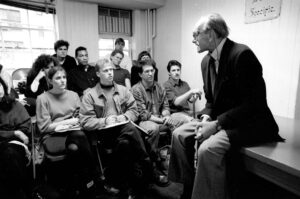

Useful Links
Contact
- The Bridge at Cecil Sharp House
- 2 Regent’s Park Rd, London NW1 7AY
- 020 7424 0860
- admin@thebridge-ttc.org
Social Media


Crying on cue means being able to deliberately induce tears on demand at any time. When acting, a scene may require for a character to cry at a certain point. Therefore the actor will need to cry on purpose at the exact right time i.e. their cue. These powerful vulnerable moments can increase the emotional impact for the audience.
Typically crying is an involuntary act in response to strong emotions that aren’t of our choosing. But it is possible to turn this into a more voluntary act or at least put yourself into an emotional state where tears will come automatically. This will enable you to cry on demand when an acting situation requires it. If you have a better understanding of how and why we cry then you’ll find it easier.
There are numerous methods you can use to cry immediately when acting. These include physical and emotional methods and you’ll want to employ a combination of both.
Stay hydrated
Obviously tears are mainly water so you’ll need enough moisture in your body to ease the crying process. If you have a crying scene coming up drink plenty of water beforehand.
Don’t blink
Try keeping your eyes open and resisting the urge to blink. If you’ve ever tried a staring competition you’ll know how quickly your eyes can get tearful.
Shallow breathing
If you breathe in a rapid shallow manner you’ll begin to active the body’s stress response which is more conducive for tears. You’ll want to keep this breathing as subtle as possible so the audience doesn’t notice.
Subtle yawning
Try a regular yawn now and you may notice your eyes tearing up. While you can’t be noticeably yawning through a scene, you can try a subtle yawn without opening your mouth but still get the tear-jerking effect.
Empathise with the character
Remember that in this moment you are the character not the actor. Think about their situation and what they’re going through as well as their background and backstory. Maybe this moment has extra meaning for them. This imaginative work should come before the performance – ideally during the line learning and character analysis stage. Each time you rehearse or perform you’ll need to tap into this. Don’t get desensitised when rehearsing over and over. Remember that each time is the first time for your character. Immerse yourself in the scene, the story, and the other people that your character is interacting with.
Use emotional memory
A good way to put yourself in your character’s shoes is to think of times you were in a similar situation or emotional state. If your character is going through a loss or break up, think of times in your life where you went though that as well. Try and recall the emotions, thought processes, and physical feelings you had at the time and utilise those in the performance.
Focus on emotion not the crying itself
Make sure to keep your attention on the emotions and the characterisation. Your aim is to experience your character’s emotions and their situation. The act of crying is not your goal. The tears should be a by-product of the emotions your character is experiencing so don’t force it. Once you feel the tears coming don’t lose focus and interrupt the crying process. Keep the emotional state going rather than thinking you’ve accomplished the goal of crying so have done enough.
Don’t be discouraged if you’ve tried the above methods and had no luck. Crying immediately on demand is not an easy task and it can take a lot of time and practice. Even veteran actors can struggle with this task. Remember that it’s not always necessary to have tears streaming down your face – which is harder to achieve. Sometimes it’s enough to just well up and have tears within the eyes. This especially applies to screen acting where being misty-eyed is more noticeable as the shot is close up on the actor’s face. It can also be enough to simply feel the emotions without crying. The audience can empathise with a character and a situation and recognise when they are experiencing heightened emotion. The important thing is to feel emotion so don’t despair or lose immersion if you fail to cry on cue.
Not every actor can cry on cue and it is not essential skill for a successful acting career. However it is definitely a useful skill to add to your the acting repertoire – and the more acting skills you have the better. It is also particularly impressive to non-actors who will typically make up the majority of your audiences. Generally most actors would do well to invest time and work in developing their ability to cry on demand.
You may find the advice above useful. However, for an approach which centres on actions, not ‘trying to cry’, you may want to look at the acting courses of The Bridge.
The Bridge’s methods are based on what the whole cast contribute, not just the individual actor. This relieves the pressure people sometimes feel when acting, leaving them free to be more creative and in the moment.

